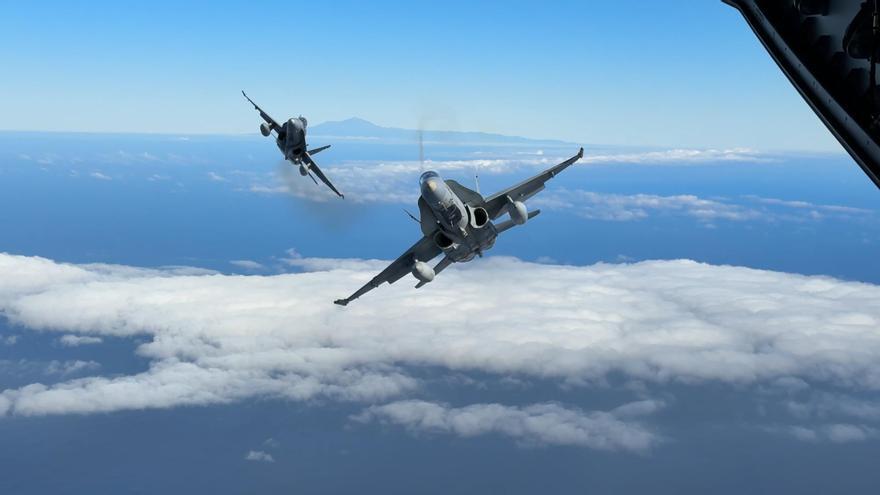Eurofighters Set for Canary Islands Arrival in 2026
The countdown has begun for the arrival of the first Eurofighter combat aircraft at Gando Air Base. The current plan states that from July 2026, these modern fighter jets will begin to be stationed in the Canary Islands. This move is part of a broader modernization of the Spanish Air and Space Force squadrons, driven by the Ministry of Defence following the signing of a multi-billion euro contract with Airbus. The new aircraft will be distributed across various Spanish military bases, including the one in Gran Canaria.
An Interim Solution for an Urgent Need
However, the first Eurofighters arriving at Gando next year will not be the latest models fresh from the factory. Due to the urgent need to relieve the F-18s that currently patrol the Canarian airspace, the initial batch will consist of the previous generation of Eurofighters already in service at the Morón and Albacete air bases. This strategic shift was confirmed by Defence Minister Margarita Robles last summer during a visit to the Los Llanos base in Albacete, where she announced that the very first jets from the Airbus factory would be destined for that base, altering initial plans that had Gando pegged as a primary recipient of the new models.
Why the Swift Change Was Necessary
The change in strategy is a direct response to the pressing need to replace Gando’s F-18s. These aircraft have been in service for over 20 years and are no longer suited to the new requirements of the islands’ air defense and the security of NATO’s southern flank. The interim solution ensures the operational capability of the Gando squadron without having to wait until 2028, the expected arrival date for the brand-new Tranche 4 models. Under this plan, the archipelago will progressively receive a contingent of aircraft that will be expanded until it reaches the necessary full complement of 18 jets.
Gando’s Strategic Role in Regional Defense
The geographical location of the Canary Islands makes Gando Air Base a strategic linchpin for air defense. The arrival of these fighters is considered essential for maintaining security in the region. While they may not be the most modern Eurofighters available, they represent the necessary technological upgrade to replace the aging F-18 fleet and uphold defense commitments.
Preparing for the New Fleet
Despite the slight delay in receiving the latest models, Gando Air Base is actively preparing for this significant transition, set for 2026. Several pilots stationed at the Gran Canaria facility have already begun training courses to qualify on the Eurofighter. Beyond initial training, these pilots will also participate in operational deployments to gain firsthand experience with these advanced aircraft, which are equipped with state-of-the-art military aviation systems. Furthermore, recent military exercises conducted in the south of the Canary Islands, with Gando as their base, provided an ideal opportunity to prepare the installation for the permanent arrival of the new fighters.
A Phased Modernization for the Spanish Air Force
The incorporation of Eurofighters into the Spanish Air and Space Force will be a gradual process over the coming years. The agreement between the Ministry of Defence and Airbus, valued at approximately €4 billion, covers the production of 25 aircraft—21 single-seat and four twin-seat models of the latest generation. This order is in addition to a previous contract for another batch of 20 fighters. These new aircraft will increase Spain’s Eurofighter fleet to 115 units, which will gradually replace part of the Air and Space Force’s F-18 fleet. The delivery schedule is set from 2026 to 2030.
Spain’s Commitment to European Defense
According to the Ministry of Defence, the Spanish Air and Space Force has been operating the Eurofighter since 2003 from its bases in Morón de la Frontera (Ala 11), near Seville, and Los Llanos (Ala 14), in Albacete. The Canary Islands’ Gando base (Ala 46) will soon become the next operational base, placing it among the three Spanish military bases to host these advanced jets. The Eurofighter is part of a European collaborative program within the NATO framework for the development and acquisition of combat aircraft, involving Germany, Italy, the United Kingdom, and Spain. The Spanish government previously decided against modernizing its military fleet with the US-made F-35 model.
A Growing Fleet and Technological Sovereignty
With these new additions, Spain is set to become the third-largest operator of Eurofighter jets in the world, trailing only Germany and the United Kingdom. This was recently highlighted by Air Force General Alejandro Chueca during the inauguration of an exhibition dedicated to the program. Spain currently has 69 active units, with the total fleet expected to reach 115 by 2035. The European fighter is cementing its role not only as the immediate future of national air defense but also as an emblem of a strategic commitment to technological sovereignty. For the Canary Islands, which had hoped to lead this new chapter from the outset, the message is clear: the Eurofighters are coming, but the most advanced models will arrive a little later.

